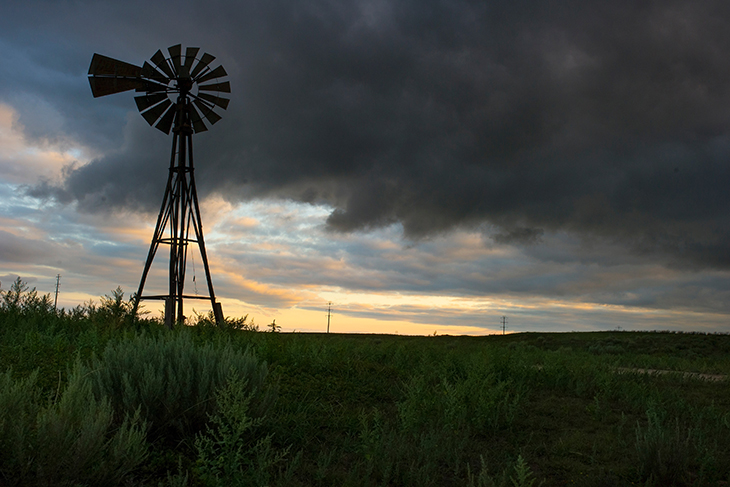
Oklahoma Mesonet’s agricultural services provide needed information in real time
Tuesday, April 16, 2019
Earl Shero of Wilburton, Oklahoma, contends the Oklahoma Mesonet allows state agricultural producers to get a peek at the future before it arrives, and use of that awareness can enhance their livestock’s well-being and business’ bottom line.
“We don’t have a rain gauge or outdoor thermometer anymore as we are about a mile from the local Mesonet tower, which gives us all the information required to make needed operational decisions in real time, and at no cost,” said Shero, a rangeland management specialist with Eastern Oklahoma State College. “People can download the free app on their phone. I use it every day on our ranch, and have done so for 20 years.”
The Oklahoma Mesonet, a world-class network of environmental monitoring stations that provide updated information every five to 10 minutes, is celebrating its 25th anniversary in 2019. A system of 120 stations with at least one in every county, the network was designed and implemented by cooperating scientists at Oklahoma State University and the University of Oklahoma, with the two universities continuing to provide valuable subject-matter expertise to this day.
“We run a ranch management program, concentrating on stocker cattle; one of the first things I have students do is download the Mesonet app on their phone and start using the data,” Shero said. “The 21st century is a data-driven world, and the Mesonet has so many useful data points available that help move an agricultural operation forward.”
Important and widely used aspects of the Mesonet’s agricultural toolset includes the general farm monitor; the cattle comfort adviser, providing environmental factors that can affect an animal’s well-being; drift risk analysis detailing when to spray pesticides, herbicides and insecticides; degree day heat units, which can affect management of crops, pastures and livestock; irrigation planning assistance; a drought monitor; and more.
“A couple of items we’re looking at right now are soil temperature and soil moisture, both of which help us plan for increased pasture resources becoming available for livestock, which affect feed costs in our operation,” Shero said.
Shero and his ranch management team, working in concert with their veterinarians, have used Mesonet data to effectively eliminate antibiotics in their animal feed and the use of mass medication applications in their livestock.
“This has not only saved us money, it has made us better stewards of our animals and the land,” he said. “Mesonet data lets us better anticipate an animal’s needs and potential health issues by showing us the conditions they will be facing in the next few days. We use that information to put into action a process to mitigate the challenges our animals will be facing.”
It is much the same for fifth-generation rancher Chuck Coffey of Double ‘C’ Cattle Company near Davis, in south central Oklahoma.
“Soil temperature and soil moisture are key right now in terms of feed management for our cattle, as well as all the weather information, given April through June is storm season in Oklahoma,” he said. “I was fortunate to be working as a rangeland specialist for the Noble Foundation in Ardmore – now the Noble Research Institute – when the Oklahoma Mesonet got started. It led me to become something of a sidekick weather guru, if you will.”
Coffey used Mesonet data not only to ascertain current and near-future conditions, but also to download data from all surrounding stations and plot out what the weather had been in previous years, using the accumulated historical data as a predictor tool, a habit he still employs today.
“The Double ‘C’ is pretty much the highest elevation in Murray County,” he said. “When I look at the Mesonet data from the Ardmore or Sulphur stations and the wind speed is 12 miles per hour, I have learned to add five to eight miles per hour on top of that. If the data tells me the relative humidity is going to drop to 30 percent, I subtract an additional 5 percent. Mesonet data is not only extremely useful, the more experience you have with the data the better you can adapt the information to your specific operation.”
A Texas A&M University alumnus with three kids who have attended Oklahoma State, Coffey is proud of the way OSU and OU work together to support agriculture through the Oklahoma Mesonet.
“It doesn’t have to be Bedlam all the time,” he said. “Agriculture is a big deal in Oklahoma, and we’re all working for the same purpose.”
Improving the quality of life for agribusiness operators and agricultural producers, their families and the communities in which they live is a key part of OSU’s state and federally mandated land-grant teaching, research and Extension mission, reminds Tom Coon, OSU vice president and dean of the university’s Division of Agricultural Sciences and Natural Resources.
“Oklahoma produces more than $8 billion in new crops and livestock annually, making agriculture an important driver of the state’s economic well-being,” he said. “This affects everyone in Oklahoma, even those who are not directly involved in agriculture.”
Oklahoma ranks fourth in the nation in the production of cattle and calves, third in meat goats, first in rye, second in canola, third in winter wheat, fourth in grain sorghum and fifth in pecans, among other highly ranked agricultural commodities.
“OSU is proud to support the breadth of the state’s agricultural industries,” Coon said. “The Oklahoma Mesonet plays a vital role in getting real-time, accurate, weather and environmental information into the hands of those who need it, and in ways that allow them to utilize the information in the most beneficial way possible. It’s also great if you just want to check out the weather.”
The Oklahoma Mesonet is available for use by the public. Find it online at mesonet.org or by visiting the App Store at Google Play or iTunes. The Oklahoma Mesonet is funded by the State of Oklahoma, partnerships with federal agencies, private-sector user fees, and grants and contracts.
